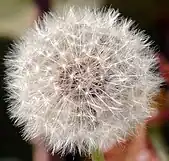Taraxacum officinale
Taraxacum officinale, the dandelion or common dandelion,[5] is a herbaceous perennial flowering plant in the daisy family Asteraceae (syn. Compositae). The common dandelion is well known for its yellow flower heads that turn into round balls of many silver-tufted fruits that disperse in the wind. These balls are called "clocks" in both British and American English.[6][7][8][9] The name "blowball" is also used.[10]
| Taraxacum officinale | |
|---|---|
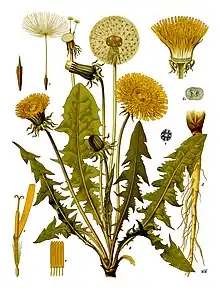 | |
| Common dandelion[1] | |
| Scientific classification | |
| Kingdom: | Plantae |
| Clade: | Tracheophytes |
| Clade: | Angiosperms |
| Clade: | Eudicots |
| Clade: | Asterids |
| Order: | Asterales |
| Family: | Asteraceae |
| Genus: | Taraxacum |
| Species: | T. officinale |
| Binomial name | |
| Taraxacum officinale | |
| Synonyms[3][4] | |
| |
The common dandelion grows in temperate regions of the world in areas with moist soils. They are very hardy plants, able to grow in a variety of environments, and are tolerant of crowding, extremes of temperature, and low moisture.[11] As a result of this hardiness, in addition to its ability to rapidly propagate itself, the dandelion has become established over a wide range via human activity, originally being native to Eurasia, but can also be found across the Americas, southern Africa, India, Australia and New Zealand as a result of incidental or deliberate introductions.
It is most often considered a weed, especially in lawns and along roadsides, but the leaves, flowers, and roots are sometimes used in herbal medicine and as food.
Description
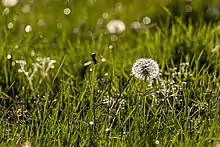
Taraxacum officinale grows from (generally unbranched) taproots and produces several hollow, leafless flower stems[12]: 470 that are typically 5–40 centimetres (2–15+3⁄4 inches) tall, but sometimes up to 70 cm (28 in) tall. The stems can be tinted purplish, they are upright or lax, and produce flower heads that are held as tall or taller than the foliage. The foliage may be upright-growing or horizontally spreading; the leaves have petioles that are either unwinged or narrowly winged. The stems can be glabrous or sparsely covered with short hairs. Plants have milky latex and the leaves are all basal; each flowering stem lacks bracts and has one single flower head. The yellow flower heads lack receptacle bracts and all the flowers, which are called florets, are ligulate and bisexual. In many lineages, fruits are mostly produced by apomixis,[13] notwithstanding the flowers are visited by many types of insects.[14]
The leaves are 5–45 cm (2–17+3⁄4 in) long and 1–10 cm (1⁄2–4 in) wide, and are oblanceolate, oblong, or obovate in shape, with the bases gradually narrowing to the petiole. The leaf margins are typically shallowly lobed to deeply lobed and often lacerate or toothed with sharp or dull teeth.[13]
The calyculi (the cuplike bracts that hold the florets) are composed of 12 to 18 segments: each segment is reflexed and sometimes glaucous. The lanceolate shaped bractlets are in two series, with the apices acuminate in shape. The 14–25 millimetres (1⁄2–1 in) wide involucres are green to dark green or brownish-green, with the tips dark gray or purplish. The florets number 40 to over 100 per head, having corollas that are yellow or orange-yellow in color.
The fruits, called cypselae,[15] range in color from olive-green or olive-brown to straw-colored to grayish, they are oblanceoloid in shape and 2–3 mm (1⁄16–1⁄8 in) long with slender beaks. The fruits have 4 to 12 ribs that have sharp edges. The silky pappi, which form the parachutes, are white to silver-white in color and around 6 mm wide. Plants typically have 24 or 40 pairs of chromosomes, while some have 16 or 32 pairs.[16]
Chemistry
| Taraxalisin | |
|---|---|
| Identifiers | |
| EC no. | ? |
| CAS no. | 217442-60-9 |
Taraxalisin is a serine proteinase found in the latex of dandelion roots.[17] Rudenskaya et al. (1998) found that taraxalisin hydrolyzes a chromogenic peptide substrate Glp-Ala-Ala-Leu-pNA optimally at pH 8.0.[18] Maximal activity of the proteinase in the roots is attained in April, at the beginning of plant development after the winter period.[18]
Taxonomy
Carl Linnaeus named the species Leontodon taraxacum in 1753. The current genus name Taraxacum derives possibly from the Arabic Tharakhchakon,[13] or from the Greek Tarraxos.[19] The specific name officinalis refers to its value as a medicinal herb, and is derived from the word opificina, later officina, meaning a workshop or pharmacy.[20]
The taxonomy of the genus Taraxacum is complicated by apomictic and polyploid lineages,[21][22] and the taxonomy and nomenclatural situation of T. officinale is not yet fully resolved.[16] The taxonomy of this genus has been complicated by the recognition of numerous species,[23] subspecies and microspecies. For example, Rothmaler's flora of Germany recognizes roughly 70 microspecies.[24]
T. officinale has a fossil record that goes back to glacial and interglacial times in Europe.[25]
North American dandelions
The plants introduced to North America, originally as a food crop, are triploids that mainly reproduce by obligate gametophytic apomixis[16][26] Though sexual dandelion plants are known in North America, almost all are clones that produce genetically identical seeds through apomixis.[27] Some authorities recognize three subspecies of Taraxacum officinale, including:[28][29]
- Taraxacum officinale subsp. ceratophorum (Ledeb.) Schinz ex Thellung which is commonly called common dandelion, fleshy dandelion, horned dandelion or rough dandelion. It is native to Canada and the western U.S.[30] Some sources list it as a species, Taraxacum ceratophorum.[31][32]
- Taraxacum officinale subsp. officinale, which is commonly called common dandelion or wandering dandelion.
- Taraxacum officinale subsp. vulgare (Lam.) Schinz & R. Keller, which is commonly called common dandelion.
Two of them have been introduced and established in Alaska and the third (subsp. ceratophorum) is native there.[33]
European dandelions
Taraxacum officinale L. (dandelion) is a vigorous weed in Europe with diploid sexual populations in the southern regions and partially overlapping populations of diploid sexuals and triploid or tetraploid apomicts in the central and northern regions.
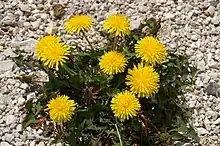
These European dandelions can be divided into two groups. The first group reproduces sexually, as do most seed plants. This group consists of dandelions that have a diploid set of chromosomes, and are sexually self-incompatible. Sexual reproduction involves a reduction of the somatic chromosome number by meiosis followed by a restoration of the somatic chromosome number by fertilization. Diploid dandelions have eight pairs of chromosomes, and meiosis is regular with normal pairing of homologous chromosomes at the metaphase I stage of meiosis.[34]
The second group consists of polyploid (mostly triploid) apomicts, meaning that both a viable embryo as well as a functional endosperm is formed without prior fertilization. In contrast to the sexual diploids, the pairing of chromosomes at metaphase I in triploid apomicts is strongly reduced. However pairing is still sufficient to allow some recombination between homologous chromosomes.[34]
Etymology
Taraxacum is derived from the Arabic word tarakhshagog (or tarakhshaqūn) for a bitter herb.[35] It may be related to the Greek word ταρασσω (tarasso) meaning to disturb.[35]
The Latin specific epithet officinale refers to the Latin word for 'medicinal' or 'of the apothecaries'.[36]
T. officinale has many English common names (some of which are no longer in use), including blowball, lion's-tooth, cankerwort, milk-witch, yellow-gowan, Irish daisy, monks-head, priest's-crown and puff-ball;[37] other common names include, faceclock, pee-a-bed, wet-a-bed,[38] swine's snout,[39] white endive, and wild endive.[40]
The common name dandelion comes from the French dent de lion, or "lion's tooth", in reference to the plant's jagged-edged leaves.[19] "Pee-a-bed" and "wet-a-bed" reflect the modern French term for the plant, pissenlit. This name and all those that imply ramped-up urine production refer to T. officinale's well-known diuretic properties.[41]
Distribution and habitat

Taraxacum officinale is native to Europe and Asia,[42] and was originally imported to America as a food crop.[43] It is now naturalized throughout North America, southern Africa, South America, New Zealand, Australia, and India. It occurs in all 50 states of the US and most Canadian provinces.[33]
The plant grows in temperate regions of the world in lawns, on roadsides, disturbed banks, shores of waterways, and other areas with moist soils.
The plant is coveted by collectors in regions where the plant is trickier to grow such as the tropics, where people would often resort to smuggling seeds from overseas.[44]
Ecology
It is considered a noxious weed in some jurisdictions,[45] and is considered to be a nuisance in residential and recreational lawns in North America.[46] It is also an important weed in agriculture and causes significant economic damage because of its infestation in many crops worldwide.[45]
T. officinale can serve as an indicator plant for soil potassium and calcium, as the plant favours soils with relatively low concentrations of calcium, but favours soils with relatively high concentrations of potassium.[47]

The dandelion is a common colonizer of disturbed habitats, both from wind blown seeds and seed germination from the seed bank.[48] The seeds remain viable in the seed bank for many years, with one study showing germination after nine years. This species is a somewhat prolific seed producer, with 54 to 172 seeds produced per head, and a single plant can produce more than 5,000 seeds a year. It is estimated that more than 97,000,000 seeds/hectare could be produced yearly by a dense stand of dandelions.[49] When released, the seeds can be spread by the wind up to several hundred meters from their source. The seeds are also a common contaminant in crop and forage seeds. The plants are adaptable to most soils and the seeds are not dependent on cold temperatures before they will germinate but they need to be within the top 2.5 cm (1 in) of soil.[33] Dandelions can also regenerate themselves from fragments of taproot.[50]
T. officinale is food for the caterpillars of several Lepidoptera (butterflies and moths), such as the tortrix moth Celypha rufana. See also List of Lepidoptera that feed on dandelions.
Even though dandelion pollen is of poor nutritional quality for honey bees, they readily consume it, and it can be an important source of nutritional diversity in heavily managed monocultures such as that of blueberries.[51][52] Honey bees have not been shown to lower their pollination activity on nearby fruit crops when foraging on dandelions.[53]
While not in bloom, this species is sometimes confused with others, such as Chondrilla juncea, that have similar basal rosettes of foliage.[54] Another plant, sometimes referred to as fall dandelion, is very similar to dandelion, but produces "yellow fields" later. Its blooms resemble some of the species of Sonchus, but are larger.[55]
Dandelion thrives in conditions of elevated carbon dioxide, growing to a higher biomass and producing a larger number of viable seeds. Therefore, it is anticipated that dandelion will become more competitive and widespread as atmospheric carbon dioxide levels increase.[27]
Uses
| Nutritional value per 100 g (3.5 oz) | |
|---|---|
| Energy | 188 kJ (45 kcal) |
9.2 g | |
| Sugars | 0.71 g |
| Dietary fiber | 3.5 g |
0.7 g | |
2.7 g | |
| Vitamins | Quantity %DV† |
| Vitamin A equiv. | 64% 508 μg54% 5854 μg13610 μg |
| Thiamine (B1) | 17% 0.19 mg |
| Riboflavin (B2) | 22% 0.26 mg |
| Niacin (B3) | 5% 0.806 mg |
| Pantothenic acid (B5) | 2% 0.084 mg |
| Vitamin B6 | 19% 0.251 mg |
| Folate (B9) | 7% 27 μg |
| Choline | 7% 35.3 mg |
| Vitamin C | 42% 35 mg |
| Vitamin E | 23% 3.44 mg |
| Vitamin K | 741% 778.4 μg |
| Minerals | Quantity %DV† |
| Calcium | 19% 187 mg |
| Iron | 24% 3.1 mg |
| Magnesium | 10% 36 mg |
| Manganese | 16% 0.342 mg |
| Phosphorus | 9% 66 mg |
| Potassium | 8% 397 mg |
| Sodium | 5% 76 mg |
| Zinc | 4% 0.41 mg |
| Other constituents | Quantity |
| Water | 85.6 g |
| |
| †Percentages are roughly approximated using US recommendations for adults. Source: USDA FoodData Central | |
The plant has several culinary uses: the flowers are used to make dandelion wine,[56] the greens are used in salads, the roots have been used to make a coffee substitute (when baked and ground into powder) and the plant was used by Native Americans as a food and medicine.[57]
Culinary
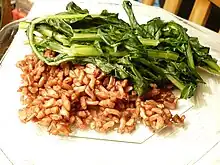
Dandelions are harvested from the wild or grown on a small scale as a leaf vegetable. The leaves (called dandelion greens) can be eaten cooked or raw in various forms, such as in soup or salad. They are probably closest in character to mustard greens. Usually the young leaves and unopened buds are eaten raw in salads, while older leaves are cooked. Raw leaves have a slightly bitter taste. Dandelion salad is often accompanied with hard-boiled eggs. The leaves are high in vitamins A and C, as well as iron, phosphorus, and potassium.[58]
Dandelion flowers can be used to make dandelion wine, for which there are many recipes.[59] Most of these are more accurately described as "dandelion-flavored wine," as some other sort of fermented juice or extract serves as the main ingredient.[60] It has also been used in a saison ale called Pissenlit (the French word for dandelion, literally meaning "wet the bed") made by Brasserie Fantôme in Belgium. Dandelion and burdock is a soft drink that has long been popular in the United Kingdom.
Another recipe using the plant is dandelion flower jam. In Silesia and other parts of Poland and the world, dandelion flowers are used to make a honey substitute syrup with added lemon (so-called May-honey). Ground roasted dandelion root can be used as a non-caffeinated coffee substitute.[61]
Diuretic
T. officinale's diuretic properties - believed to be a result of the plant’s high potassium content[62] - have been well described, with the leaves of this plant having been used for this purpose in traditional Chinese medicine for approximately 2,000 years, with other regions of the world using the plant in the same way; in French, a common name for T. officinale is pissenlit, 'a colorful description of its diuretic activity.' A study conducted in 2009 noted 'promising' results regarding these diuretic properties, but that further studies would need to be conducted into the plant's efficacy.[63]
Herbal medicine
Dandelion has been used in traditional medicine in Europe, North America, and China.[64]
Research
Since asexually-reproducing dandelions produce genetically identical offspring, they are often useful as subjects for scientific research. For example, dandelions are used in studies where genetic differences between subjects need to be minimized.[65]
Education
Because of its worldwide distribution, familiarity, and presence in a wide variety of folkloric traditions, the dandelion has been highlighted as a valuable tool for educators seeking to help children of varying cultural and ethnic backgrounds connect to science through ethnobotany.[66]
In culture
Cultures worldwide tell stories about the dandelion and have culinary and medicinal uses for it. A Native American folktale tells the story of a golden haired girl who attracted the fancy of the South Wind. The South Wind was too lazy to pursue her, until one day he realized she had grown old and her hair had turned white. Supposedly, when the South Wind sighs over the loss of his chance to pursue the golden-haired girl, his breath sends the white-haired dandelion seeds scattering to propagate more golden-haired daughters.[66]
See also
References
- 1897 illustration from Franz Eugen Köhler, Köhler's Medizinal-Pflanzen
- "IUCN Red List of Threatened Species: Taraxacum officinale". 5 April 2013.
- "Tropicos - Name - !Taraxacum officinale F.H. Wigg". tropicos.org.
- "Taraxacum campylodes G.E.Haglund — The Plant List". theplantlist.org.
- USDA, NRCS (n.d.). "Taraxacum officinale". The PLANTS Database (plants.usda.gov). Greensboro, North Carolina: National Plant Data Team. Retrieved 8 December 2015.
- "Definition of "blowball" - Collins English Dictionary". collinsdictionary.com.
- "blowball: meaning and definitions". infoplease.com.
- "dandelion clock - Definition from Longman English Dictionary Online". Ldoceonline.com. Retrieved 2010-07-03.
- "Clock dictionary definition - clock defined". yourdictionary.com.
- "blowball". TheFreeDictionary.com.
- "Dandelion, Taraxacum officinale". Wisconsin Horticulture. Retrieved 2023-10-02.
- Rose, Francis (2006). The wild flower key. London: Penguim BooksLtd. ISBN 978-0-7232-5175-0.
- Morley, T. I. (1969). "Spring Flora of Minnesota". 1974 Reprint with Minor Corrections: 255.
- Van Der Kooi, C. J.; Pen, I.; Staal, M.; Stavenga, D. G.; Elzenga, J. T. M. (2015). "Competition for pollinators and intra-communal spectral dissimilarity of flowers". Plant Biology. 18 (1): 56–62. doi:10.1111/plb.12328. PMID 25754608.
- "Cypsela". Steere Herbarium, New York Botanical Garden. Retrieved 18 February 2020.
- "Taraxacum officinale in Flora of North America @". Efloras.org. Retrieved 2011-10-23.
- Bogacheva, A. M.; Rudenskaya, G. N.; Preusser, A; Tchikileva, I. O.; Dunaevsky, Y. E.; Golovkin, B. N.; Stepanov, V. M. (1999). "A new subtilisin-like proteinase from roots of the dandelion Taraxacum officinale Webb S. L.". Biochemistry. Biokhimiia. 64 (9): 1030–7. PMID 10521720.
- Rudenskaya, G. N.; Bogacheva, A. M.; Preusser, A.; Kuznetsova, A. V.; Dunaevsky YaE, null; Golovkin, B. N.; Stepanov, V. M. (1998-10-23). "Taraxalisin -- a serine proteinase from dandelion Taraxacum officinale Webb s.l". FEBS Letters. 437 (3): 237–240. doi:10.1016/s0014-5793(98)01243-5. ISSN 0014-5793. PMID 9824298. S2CID 43872064.
- Kowalchik, Claire; Hylton, William H.; Carr, Anna (1987). Rodale's illustrated encyclopedia of herbs. Emmaus, Pa.: Rodale Press. p. 141. ISBN 978-0-87857-699-9.
- Stearn, W.T. (1992). Botanical Latin: History, grammar, syntax, terminology and vocabulary, Fourth edition. David and Charles.
- Wittzell, Hakan (1999). "Chloroplast DNA variation and reticulate evolution in sexual and apomictic sections of dandelions". Molecular Ecology. 8 (12): 2023–35. doi:10.1046/j.1365-294x.1999.00807.x. PMID 10632854. S2CID 25180463.
- Dijk, Peter J. van (2003). "Ecological and evolutionary opportunities of apomixis: insights from Taraxacum and Chondrilla". Philosophical Transactions of the Royal Society B. 358 (1434): 1113–21. doi:10.1098/rstb.2003.1302. PMC 1693208. PMID 12831477.
- Thomas Gaskell Tutin (1976). Flora Europaea: Plantaginaceae to Compositae (and Rubiaceae). Cambridge University Press. pp. 332–. ISBN 978-0-521-08717-9. Retrieved 29 October 2010.
- Rothmaler, Werner (1966). Exkursionsflora: Kritischer Ergänzungsband Gefäßpflanzen. p. 347.
- "Taraxacum officinale complex (dandelion)". Cabi.org. Retrieved 2019-06-17.
- Lyman JC, Ellstrand NC (1984). "Clonal diversity in Taraxacum officinale (Compositae), an apomict". Heredity. 53 (1): 1–10. doi:10.1038/hdy.1984.58.
- McPeek, Tamara M.; Wang, Xianzhong (2007). "Reproduction of Dandelion (Taraxacum officinale) in a Higher CO2 Environment". Weed Science. 55 (4): 334–340. doi:10.1614/WS-07-021. S2CID 86250272.
- "ITIS Standard Report Page: Taraxacum officinale". Itis.gov. 2010-05-13. Retrieved 2011-10-23.
- Robert F. Barnes; C. Jerry Nelson; Kenneth J. Moore; Michael Collins (19 January 2007). Forages: The science of grassland agriculture. Wiley-Blackwell. pp. 11–. ISBN 978-0-8138-0232-9. Retrieved 29 October 2010.
- "PLANTS Profile for Taraxacum officinale ssp. ceratophorum (common dandelion) | USDA PLANTS". Plants.usda.gov. Retrieved 2011-10-23.
- "Taraxacum ceratophorum". Calflora. Retrieved 2011-10-23.
- "Taraxacum ceratophorum in Flora of North America @". Efloras.org. Retrieved 2011-10-23.
- "What is AKEPIC? | Alaska Natural Heritage Program" (PDF). Akweeds.uaa.alaska.edu. 2010-11-15. Retrieved 2011-10-23.
- van Baarlen P, van Dijk PJ, Hoekstra RF, de Jong JH (October 2000). "Meiotic recombination in sexual diploid and apomictic triploid dandelions (Taraxacum officinale L.)". Genome. 43 (5): 827–35. doi:10.1139/g00-047. PMID 11081973.
- Gledhill, David (2008). The Names of Plants. Cambridge University Press. ISBN 9780521866453 (hardback), ISBN 9780521685535 (paperback). pp 279, 371
- Coombes, Allen (2012). The A to Z of Plant Names: A Quick Reference Guide to 4000 Garden Plants. Portland, OR, US: Timber Press. p. 40. ISBN 9781604691962.
- Britton, N. F.; Brown, Addison (1970). An illustrated flora of the northern United States and Canada: from Newfoundland to the parallel of the southern boundary of Virginia, and from the Atlantic Ocean westward to the 102d meridian. New York: Dover Publications. p. 315. ISBN 978-0-486-22644-6.
- "Alaska (U.S. National Park Service)" (PDF). Nps.gov. 2018-12-19. Retrieved 2019-06-17.
- Loewer, Peter (2001). Solving weed problems. Guilford, Conn.: Lyons Press. p. 210. ISBN 978-1-58574-274-5.
Swine's Snout.
- "Dandelion clock". TheFreeDictionary.com.
- Clare, B. A.; Conroy, R. S.; Spelman, K. (2009). "The Diuretic Effect in Human Subjects of an Extract of Taraxacum officinale Folium over a Single Day". Journal of Alternative and Complementary Medicine. 15 (8): 929–934. doi:10.1089/acm.2008.0152. PMC 3155102. PMID 19678785.
- Vít Bojňanský; Agáta Fargašová (2007). Atlas of Seeds and Fruits of Central and East-European Flora: The Carpathian Mountains Region. シュプリンガー・ジャパン株式会社. pp. 751–. ISBN 978-1-4020-5361-0. Retrieved 29 October 2010.
- Tekiela, Stan (1999). Wildflowers of Minnesota: Field Guide. Cambridge, Minnesota: Adventure Publications, Inc. p. 343. ISBN 978-1-885061-63-8.
- Wong, James (16 May 2021). "Why the dandelion blows away some plant collectors". The Guardian. Retrieved 9 September 2021.
- Stewart-Wade, S. M.; S. Newmann; L.L.Collins; G.J. Boland (2002). "The biology of Canadian weeds. 117. Taraxacum officinale G.H. Weber ex Wiggers". Canadian Journal of Plant Science. 82 (4): 825–853. doi:10.4141/P01-010.
- Richardson, Jonathan (1985). "In praise of the archenemy". Audubon. 87: 37–39.
- Almanac, Old Farmer's. "Weeds as Indicator Plants". Old Farmer's Almanac. Retrieved 2020-04-10.
- "Taraxacum officinale". Fs.fed.us. Retrieved 2011-10-23.
- Binning, Kim (2002). "Dandelion". University of Wisconsin Weed Science Cooperative Extension.
- Martinkova, Zdenka; Honek, Alois; Pekar, Stano (2014). "The Role of Nurse Plants in Facilitating the Germination of Dandelion (Taraxacum officinale) Seeds". Weed Science. 62 (3): 474–482. doi:10.1614/WS-D-13-00162.1. S2CID 85658841.
- Schmidt, Justin O.; Thoenes, Steven C.; Levin, M.D. (1987). "Survival of honey bees, Apis mellifera (Hymenoptera: Apidae), fed various pollen sources". Annals of the Entomological Society of America. 80 (2): 176–183. doi:10.1093/aesa/80.2.176.
- Girard, Mélissa; Chagnon, Madeleine; Fournier, Valérie (2012). "Pollen diversity collected by honey bees in the vicinity of Vaccinium spp. crops and its importance for colony development". Botany. 90 (7): 545–555. doi:10.1139/b2012-049. hdl:20.500.11794/39125.
- Laverty, Terence; Hiemstra, Henry (1998). "Effects of flowering dandelions as a competitor to flowers of fruit trees for pollen-collecting honey bees in Ontario". The Proceedings of the Entomological Society of Ontario. 129: 3–8.
- Stewart-Wade, S. M.; Neumann, S.; Collins, L. L.; Boland, G. J. (2002-10-01). "The biology of Canadian weeds. 117. Taraxacum officinale G. H. Weber ex Wiggers". Canadian Journal of Plant Science. 82 (4): 825–853. doi:10.4141/P01-010. ISSN 0008-4220.
- Sonchus North Carolina Extension Gardener Plant Toolbox
- "Recipes - Dandelion Wine". Cooks.com. Retrieved 2011-10-23.
- Clarke, Charlotte Bringle (1977). Edible and useful plants of California. Berkeley: University of California Press. p. 191. ISBN 978-0-520-03261-3.
- Benoliel, Doug (2011). Northwest Foraging: The Classic Guide to Edible Plants of the Pacific Northwest (Rev. and updated ed.). Seattle, WA: Skipstone. p. 73. ISBN 978-1-59485-366-1. OCLC 668195076.
- "winemaking: Dandelion Wines". Winemaking.jackkeller.net. 2004-05-22. Retrieved 2012-07-20.
- Gibbons, E. Stalking the Wild Asparagus. David McKay, New York. 1962.
- Sztabowa, Wera (1990). Krupnioki i moczka, czyli gawędy o śląskiej kuchni. Wydawnictwo Śląsk, Katowice, ISBN 83-216-0935-X.
- Dog, Tieraona Low (2005-01-01), Dog, Tieraona Low (ed.), "CHAPTER 18 - Urinary Tract Infection", Women's Health in Complementary and Integrative Medicine, Saint Louis: Churchill Livingstone, pp. 293–306, ISBN 978-0-443-06639-9, retrieved 2022-09-14
- Clare, Bevin A.; Conroy, Richard S.; Spelman, Kevin (August 2009). "The Diuretic Effect in Human Subjects of an Extract of Taraxacum officinale Folium over a Single Day". Journal of Alternative and Complementary Medicine. 15 (8): 929–934. doi:10.1089/acm.2008.0152. ISSN 1075-5535. PMC 3155102. PMID 19678785.
- Katrin Schütz, Reinhold Carle & Andreas Schieber (2006). "Taraxacum—a review on its phytochemical and pharmacological profile". Journal of Ethnopharmacology. 107 (3): 313–323. doi:10.1016/j.jep.2006.07.021. PMID 16950583.
- Adams, Keith L. (2010). "Dandelions 'remember' stress: heritable stress-induced methylation patterns in asexual dandelions". The New Phytologist. 185 (4): 867–868. doi:10.1111/j.1469-8137.2010.03189.x. PMID 20356338.
- Esprivalo, Pamela Sue; Forney, Scott (2001). "Cultivating Cultural Appreciation: ADDRESSING DIVERSITY THROUGH ETHNOBOTANY". The Science Teacher. 68 (3).
- Dyer, A. (1976). Dyes from Natural Sources. G. Bell & Sons Ltd., London
- The Complete Guide to Edible Wild Plants. United States Department of the Army. New York: Skyhorse Publishing. 2009. p. 49. ISBN 978-1-60239-692-0. OCLC 277203364.
{{cite book}}: CS1 maint: others (link)
Further reading
- Blanchan, Neltje (2005). Wild Flowers Worth Knowing. Project Gutenberg Literary Archive Foundation. ISBN 978-0-665-98934-6.
- Everitt, J.H.; Lonard, R.L.; Little, C.R. (2007). Weeds in South Texas and Northern Mexico. Lubbock: Texas Tech University Press. ISBN 978-0-89672-614-7. ISBN 0-89672-614-2
- Köhler, Franz Eugen (1887). Köhler's Medicinal Plants. Gustav Pabst.
- Vorobyev, G.; Alyabyev, A.; Ogorodnikova, T.; Khamidullin, A.; Vorobyev, V. (April 5, 2014). "Adaptive properties of the dandelion (Taraxacum officinale Wigg. s.l.) under conditions of air pollution by motor vehicle exhausts". Russian Journal of Ecology. 45 (2): 90–94. doi:10.1134/S1067413614020106. S2CID 9147896.
- Kenny, O.; Brunton, N. P.; Walsh, D. (April 2015). "Characterisation of Antimicrobial Extracts from Dandelion Root (Taraxacum officinale)". Phytotherapy Research. 29 (4): 526–532. doi:10.1002/ptr.5276. PMID 25644491. S2CID 5564213.
External links
- Northernbushcraft.com: Dandelion (Taraxacum officinale) — detailed information about edibility.

.jpg.webp)
